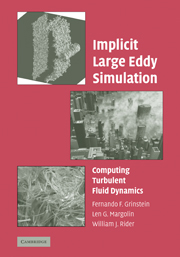Book contents
- Frontmatter
- Contents
- Preface
- List of Acronyms
- List of Contributors
- Introduction
- SECTION A MOTIVATION
- SECTION B CAPTURING PHYSICS WITH NUMERICS
- 3 Subgrid-Scale Modeling: Issues and Approaches
- 4 Numerics for ILES
- 5 Numerical Regularization: The Numerical Analysis of Implicit Subgrid Models
- 6 Approximate Deconvolution
- SECTION C VERIFICATION AND VALIDATION
- SECTION D FRONTIER FLOWS
- Index
- Plate section
5 - Numerical Regularization: The Numerical Analysis of Implicit Subgrid Models
from SECTION B - CAPTURING PHYSICS WITH NUMERICS
Published online by Cambridge University Press: 08 January 2010
- Frontmatter
- Contents
- Preface
- List of Acronyms
- List of Contributors
- Introduction
- SECTION A MOTIVATION
- SECTION B CAPTURING PHYSICS WITH NUMERICS
- 3 Subgrid-Scale Modeling: Issues and Approaches
- 4 Numerics for ILES
- 5 Numerical Regularization: The Numerical Analysis of Implicit Subgrid Models
- 6 Approximate Deconvolution
- SECTION C VERIFICATION AND VALIDATION
- SECTION D FRONTIER FLOWS
- Index
- Plate section
Summary
Introduction
In this chapter we extend our study of the underlying justification of implicit large eddy simulation (ILES) to the numerical point of view. In Chapter 2 we proposed that the finite-volume equations, found by integrating the governing partial differential equations (PDEs) over a finite region of space and time, were more appropriate models for describing the behavior of discrete parcels of fluid, including computational cells in numerical simulation. However, effective simulation of turbulent flows must consider not only issues of accuracy but also those of computational stability. Here we introduce and apply the machinery of modified equation analysis (MEA) to identify the properties of discrete algorithms and to compare different algorithms. We then apply MEA to several of the nonoscillatory finite-volume (NFV) methods described in Chapter 4, with the goal of identifying those elements essential to successful ILES. In the process we make connections to the some of the explicit subgrid models discussed in Chapter 3, thus demonstrating that many subgrid models implicit within NFV methods are closely related to existing explicit models. MEA is also applied with the methods description in Chapter 4a.
We consider the answer to this question: What are the essential ingredients of a numerical scheme that make it a viable basis for ILES? Many of our conclusions are based on MEA, a technique that processes discrete equations to produce a PDE that closely represents the behavior of a numerical algorithm (see Hirt 1968; Fureby and Grinstein 2002; Margolin and Rider 2002; Grinstein and Fureby 2002; Margolin and Rider 2005).
Information
- Type
- Chapter
- Information
- Implicit Large Eddy SimulationComputing Turbulent Fluid Dynamics, pp. 195 - 221Publisher: Cambridge University PressPrint publication year: 2007
Accessibility standard: Unknown
Why this information is here
This section outlines the accessibility features of this content - including support for screen readers, full keyboard navigation and high-contrast display options. This may not be relevant for you.Accessibility Information
- 10
- Cited by
